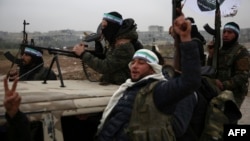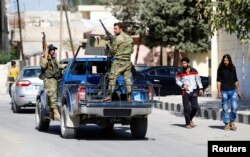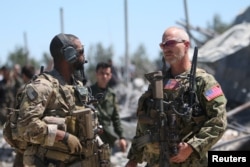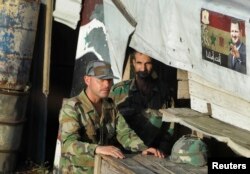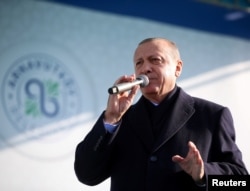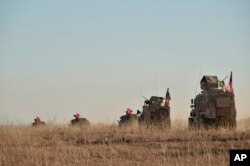Major players in and around Syria have started positioning their forces as discussions get under way on how to proceed once U.S. forces vacate the country and their fight against the last remnants of the Islamic State terror group's self-proclaimed caliphate.
The pace of troop movements, along with diplomatic outreach, intensified Monday, the same day the Pentagon confirmed outgoing Defense Secretary Jim Mattis ordered U.S. troops to start leaving Syria, without elaborating.
"The execute order for Syria has been signed," a U.S. defense official confirmed to VOA, adding, "I am not going to provide more operational details at this time."
Turkey
U.S. President Donald Trump tweeted Sunday about a telephone conversation he had with Turkish President Recep Tayyip Erdogan.
Erdogan's spokesman said Monday Turkish defense officials would meet with their U.S. counterparts later this week.
"They will discuss how to coordinate (the withdrawal)," spokesman Ibrahim Kalin said following a Cabinet meeting Monday in Ankara, promising there would be no slowdown in the fight against IS.
"Americans have uttered numbers such as 30-60 days, 60-100 days. We will see about that," he added. "This will have more to do with the coordination of the withdrawal process in the field."
Kalin also said Turkey planned to work closely with Russia on the future of Syria, sentiments echoed by Russian Foreign Minister Sergey Lavrov.
"We are cooperating with Turkey and Iran," Lavrov told a Russian news agency, according to a transcript posted on the Russian Foreign Ministry's website.
"We will see what President Donald Trump's declared decision to pull out of Syria comes to," he added.
Trump's surprise announcement last week that U.S. forces would be leaving Syria also has Washington's main partner on the ground in Syria, an alliance of Kurdish and Arab militias known as the Syrian Democratic Forces, or SDF, looking to make a deal with Russia, Syria or even Iran.
"If Trump doesn't change his mind and serious threats continue against Kurdish people, then we will have no choice but to work with others. It would be a bitter choice, but certainly better than a Turkish invasion," an official with the People's Protection Units (YPG), the main Kurdish group in Syria, told VOA last week on condition of anonymity.
U.S.-backed forces have also raised concerns about what to do with hundreds of captured IS foreign fighters. SDF officials have said they may have no choice but to release more than 1,000 prisoners and their families unless they are somehow able to work out a deal with the Syrian government.
Russian-backed Syrian government
Already, SDF officials have met with Russian representatives in Moscow. A source close to SDF leadership told VOA the expectations are that Russian-backed Syrian forces will move into some of the areas the SDF vacates once the U.S. leaves.
If that plays out, though, it could set up a conflict with Turkey, which despite U.S. support for the YPG in Syria, considers the YPG a terrorist group with strong ties to the Kurdistan Workers Party, or PKK. The PKK has been fighting a long insurgency for more Kurdish autonomy in Turkey.
During a speech Friday, Erdogan promised to hold off on a planned military operation aimed at destroying elements of the YPG in Syria, although he added the campaign would still get under way in the coming months.
In the meantime, Turkey has been working to strengthen its military position both along the Syrian border and by proxy forces already inside the country.
"Yesterday units from the Syrian National Army headed towards the Manbij front and took preliminary positions [in preparation] for the battle," Major Youssef Hamoud, the spokesman for the Turkish-backed National Army, told Reuters.
Manbij, a town in northern Syria, has been a flashpoint between Turkish forces and Kurdish militias. U.S. and Turkish forces had been conducting joint patrols around Manbij, and the U.S. set up a series of observation posts in the areas last month to help ease tensions.
Forces on the move
Reports from the region indicate other forces are also on the move as they, too, prepare for the U.S. troop withdrawal.
The London-based Syrian Observatory for Human Rights said Monday that "military reinforcements of the [Syrian] regime forces and their allies have reached al-Mayadin and al-Bokamal areas on the western bank of Euphrates River, in the eastern sector of Deir el-Zour countryside."
The reinforcements, which also brought additional armored vehicles and ammunition, are joining with Iranian militias already in the area.
Mayadin and Boukamal are to the north and south respectively, of the town of Hajin, which has seen fierce fighting and an increase in U.S. and coalition airstrikes in recent weeks as U.S.-backed forces battle about 2,000 IS fighters who are clinging to the last sliver of the terror group's caliphate.
"We are transitioning primary responsibility for the defeat of the few remaining ISIS remnants in Syria to our allies and partners on the ground inside Syria," a U.S. administration official told VOA Friday, using an acronym for the Islamic State group.
President Trump late Sunday signaled it will be Turkey, and not the Kurdish and Arab SDF fighters, that will finish the job against IS.
On Monday, Trump further defended his decision to declare victory over the IS caliphate and pull U.S. troops from Syria, tweeting criticism of both outgoing Defense Secretary Jim Mattis and former Special Envoy Brett McGurk.
Mattis delivered his resignation letter to Trump at the White House last week, citing differences with the president over the importance of alliances. Senior defense officials have said Trump's decision to abandon U.S. allies on the ground in Syria was more than Mattis could accept.
"We cannot protect our interests...without maintaining strong alliances and showing respect to those allies," Mattis wrote in his letter.
VOA Watch Desk's Sirwan Kajjo contributed to this report.




